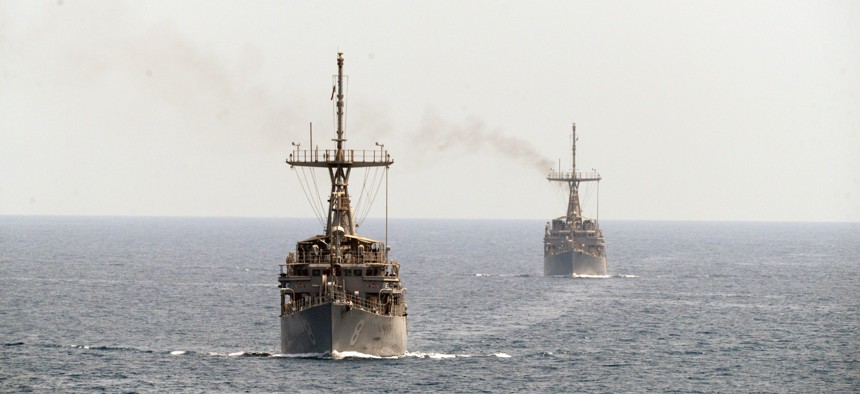
The mine countermeasure ships USS Scout (MCM 8), left, and USS Gladiator (MCM 11), transit the Strait of Hormuz. Navy Media Content Services
US Navy Accompanies First Four Ships Through Strait of Hormuz
DOD officials are coordinating with shipping companies.
U.S. naval forces have begun accompanying U.S.-flagged ships through the Strait of Hormuz, a senior U.S. defense official said Thursday. The announcement comes two days after Iranian forces seized a cargo ship sailing under the flag of the Marshall Islands and forced it to anchor off the Iranian coast.
Update (5/1): As of midday Friday, Washington time, Navy ships had accompanied three vessels into the Persian Gulf and one out of it, said Pentagon spokesman Col. Steve Warren. All were Military Sealift Command or U.S. government contract vessels, he said.
“Any US-flagged vessel that desires that support can ask; but they certainly will not be compelled to accept the accompaniment of US naval forces through the Strait. It's an offer that we've made and it's been positively received in the Navy's discussions with shipping industry representatives, but they're certainly not compelled, not required. Only if they're desired,” said CENTCOM spokesman Air Force Col. Patrick Ryder. “Our current plans are for accompanying US-flagged ships, although there are discussions with other nations to include their vessels as well. But for obvious reasons, we'll leave discussions of those particular nations to make any type of announcement.”
Warren said the operation had been approved by Defense Secretary Ashton Carter in response to the seizure of the MV Maersk Tigris and the earlier harassment of the MV Maersk Kensington, and that it currently has no end date.
As reported first by CNN, U.S. Naval Forces Central Command is coordinating with U.S.-flagged shipping companies to ensure safe passage, the senior official said.
(Related: What’s the Difference Between ‘Accompanying’ and ‘Escorting’ a Ship?)
A spokesman for the Navy's Fifth Fleet, Cmdr. Kevin Stephens, said, “In general, U.S. naval forces will now accompany U.S.-flagged vessels that desire such support during transits of the Strait of Hormuz. U.S. naval forces will transit the strait along with and nearby such shipping, although it is not as though they'll necessarily be in some sort of formation.”
Another defense official stressed the word “accompanying.”
“Accompanying is basically a step down from escorting,” the second official said. “The U.S. Navy ships will be in the same general area as the U.S.-flagged merchant vessels and are there to ensure a safe flow of maritime traffic in the Strait of Hormuz.”
“It’s not ‘get in a convoy,’” the official said. “This is part of the Navy’s job. This is what we’ve been doing for a long time.”
Leadership Briefing Breakfast: Join Navy Secretary Ray Mabus on May 20 for a conversation with Defense One's Executive Editor Kevin Baron. Register now.
As well, CNN reported that this new effort “specifically requires an armed warship to be in the narrow channel between Iran and Oman when a U.S. commercial vessel passes through.”
The senior official said the U.S. has sufficient resources in the area to carry out the mission. According to Navy Times, Navy ships in the region include the aircraft carrier Theodore Roosevelt; the cruiser Normandy; the destroyers Milius, Farragut, Winston S. Churchill and Paul Hamilton; the coastal patrol ships Whirlwind, Monsoon, Typhoon, Thunderbolt and Firebolt; and the minesweeper Devastator. As well, maritime patrol aircraft are available to keep an eye on things.
On April 28, patrol boats belonging to the Iranian Revolutionary Guard Corps Navy, or IRGCN, fired a shot across the bow of the container ship Maersk Tigris, directed it toward an Iranian port, and have prevented it from leaving. Iranian officials say they are acting legally to resolve a 10-year-old dispute with the Maersk shipping company over 10 shipping containers. Maersk officials have said they are working to resolve the situation and free their ship and crew.
The Navy, which routinely keeps an aircraft carrier and its battle group of escort ships in or near the Gulf, immediately dispatched the Farragut, some 60 miles away, to monitor the situation. Meanwhile, U.S. officials are reportedly talking with counterparts in the Marshall Islands, trying to work out their rights and responsibilities regarding ships flagged under the flag of the Pacific nation. The United States provides military protection to the Marshall Islands under a bilateral agreement.
The current episode is part of a long history of confrontations between U.S. and Iranian naval forces. In 1987-88, the Gulf was the scene of Operation Earnest Will, the most intensive escort operation since World War II. The operation involved dozens of U.S. warships shepherding convoys of reflagged Kuwaiti tankers through the strait during the Iraq-Iraq War.
Ben Watson contributed to this report. It has been updated several times since it was first posted.




